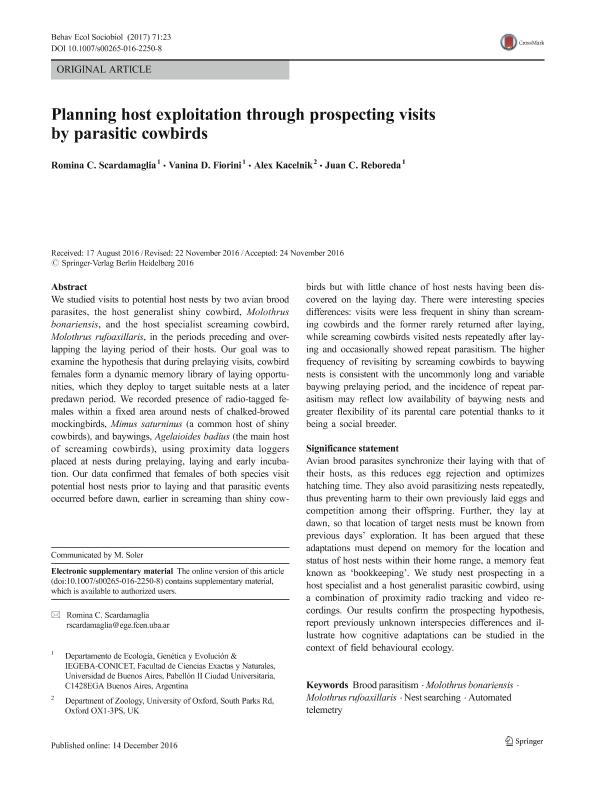Artículo
Planning host exploitation through prospecting visits by parasitic cowbirds
Fecha de publicación:
01/2017
Editorial:
Springer
Revista:
Behavioral Ecology And Sociobiology
ISSN:
0340-5443
Idioma:
Inglés
Tipo de recurso:
Artículo publicado
Clasificación temática:
Resumen
Abstract: We studied visits to potential host nests by two avian brood parasites, the host generalist shiny cowbird, Molothrus bonariensis, and the host specialist screaming cowbird, Molothrus rufoaxillaris, in the periods preceding and overlapping the laying period of their hosts. Our goal was to examine the hypothesis that during prelaying visits, cowbird females form a dynamic memory library of laying opportunities, which they deploy to target suitable nests at a later predawn period. We recorded presence of radio-tagged females within a fixed area around nests of chalked-browed mockingbirds, Mimus saturninus (a common host of shiny cowbirds), and baywings, Agelaioides badius (the main host of screaming cowbirds), using proximity data loggers placed at nests during prelaying, laying and early incubation. Our data confirmed that females of both species visit potential host nests prior to laying and that parasitic events occurred before dawn, earlier in screaming than shiny cowbirds but with little chance of host nests having been discovered on the laying day. There were interesting species differences: visits were less frequent in shiny than screaming cowbirds and the former rarely returned after laying, while screaming cowbirds visited nests repeatedly after laying and occasionally showed repeat parasitism. The higher frequency of revisiting by screaming cowbirds to baywing nests is consistent with the uncommonly long and variable baywing prelaying period, and the incidence of repeat parasitism may reflect low availability of baywing nests and greater flexibility of its parental care potential thanks to it being a social breeder. Significance statement: Avian brood parasites synchronize their laying with that of their hosts, as this reduces egg rejection and optimizes hatching time. They also avoid parasitizing nests repeatedly, thus preventing harm to their own previously laid eggs and competition among their offspring. Further, they lay at dawn, so that location of target nests must be known from previous days’ exploration. It has been argued that these adaptations must depend on memory for the location and status of host nests within their home range, a memory feat known as ‘bookkeeping’. We study nest prospecting in a host specialist and a host generalist parasitic cowbird, using a combination of proximity radio tracking and video recordings. Our results confirm the prospecting hypothesis, report previously unknown interspecies differences and illustrate how cognitive adaptations can be studied in the context of field behavioural ecology.
Archivos asociados
Licencia
Identificadores
Colecciones
Articulos(IEGEBA)
Articulos de INSTITUTO DE ECOLOGIA, GENETICA Y EVOLUCION DE BS. AS
Articulos de INSTITUTO DE ECOLOGIA, GENETICA Y EVOLUCION DE BS. AS
Citación
Scardamaglia, Romina Clara; Fiorini, Vanina Dafne; Kacelnik, Alex; Reboreda, Juan Carlos; Planning host exploitation through prospecting visits by parasitic cowbirds; Springer; Behavioral Ecology And Sociobiology; 71; 1; 1-2017; 1-10
Compartir
Altmétricas




